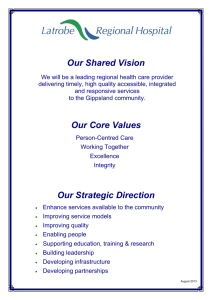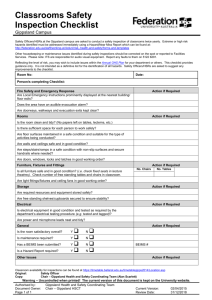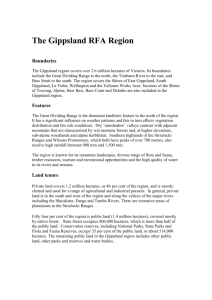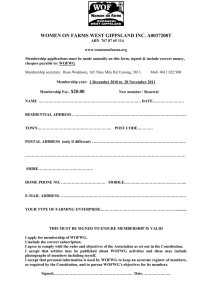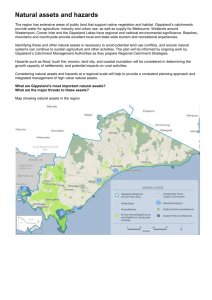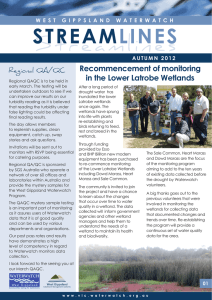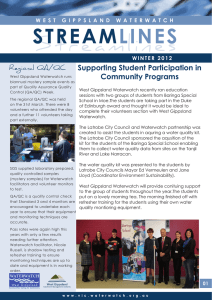Gippsland STREAMLINES Inside This Issue:
advertisement
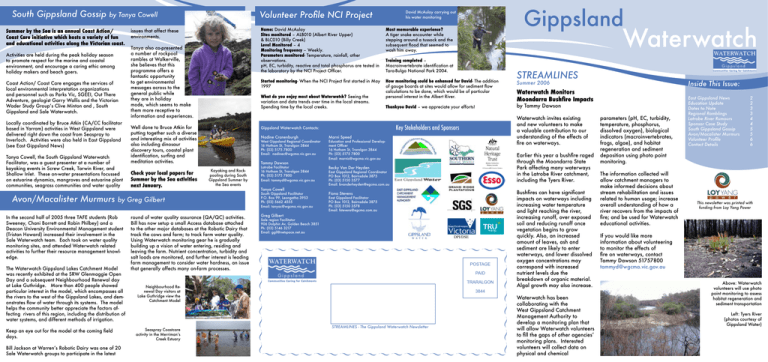
South Gippsland Gossip Volunteer Profile NCI Project by Tanya Cowell Summer by the Sea is an annual Coast Action/ Coast Care initiative which hosts a variety of fun and educational activities along the Victorian coast. Activities are held during the peak holiday season to promote respect for the marine and coastal environment, and encourage a caring ethic among holiday makers and beach goers. Coast Action/ Coast Care engages the services of local environmental interpretation organizations and personnel such as Parks Vic, SGEEI, Out There Adventure, geologist Garry Wallis and the Victorian Wader Study Groupʼs Clive Minton and , South Gippsland and Sale Waterwatch. Locally coordinated by Bruce Atkin (CA/CC facilitator based in Yarram) activities in West Gippsland were delivered right down the coast from Seaspray to Inverloch. Activities were also held in East Gippsland (see East Gippsland News) Tanya Cowell, the South Gippsland Waterwatch Facilitator, was a guest presenter at a number of kayaking events in Screw Creek, Tarwin River, and Shallow Inlet. These on-water presentations focussed on estuarine dynamics, mangroves and estuarine plant communities, seagrass communities and water quality Avon/Macalister Murmurs issues that affect these environments. Tanya also co-presented a number of rockpool rambles at Walkerville, she believes that this programme offers a fantastic opportunity to get environmental messages across to the general public while they are in holiday mode, which seems to make them more receptive to information and experiences. Check your local papers for Summer by the Sea activities next January. The Waterwatch Gippsland Lakes Catchment Model was recently exhibited at the SRW Glenmaggie Open Day and a subsequent Neighbourhood Renewal day at Lake Guthridge. More than 400 people showed particular interest in the model, which encompasses all the rivers to the west of the Gippsland Lakes, and demonstrates flow of water through its systems. The model helps the community better appreciate the factors affecting rivers of this region, including the distribution of water systems, and different methods of irrigation. Keep an eye out for the model at the coming field days. Bill Jackson at Warrenʼs Robotic Dairy was one of 20 Sale Waterwatch groups to participate in the latest Most memorable experience? A tiger snake encounter while stepping around a tussock and the subsequent flood that seemed to wash him away. Started monitoring- When the NCI Project first started in May 1997 How monitoring could be enhanced for David- The addition of gauge boards at sites would allow for sediment flow calculations to be done, which would be of particular personal interest in the Albert River. Training completed – Macroinvertebrate identification at Tara-Bulga National Park 2004. Nadine Cranenburgh West Gippsland Regional Coordinator 16 Hotham St, Traralgon 3844 Ph: (03) 5175 7800 Email: nadinec@wgcma.vic.gov.au Tammy Dawson Kayaking and Rockpooling during South Gippsland Summer by the Sea events round of water quality assurance (QA/QC) activities. Bill has now setup a small Access database attached to the other major databases at the Robotic Dairy that track the cows and farm; to track farm water quality. Using Waterwatch monitoring gear he is gradually building up a vision of water entering, residing and leaving the farm. Nutrient concentration, turbidity and salt loads are monitored, and further interest is leading farm management to consider water hardness, an issue that generally affects many on-farm processes. Latrobe Facilitator 16 Hotham St, Traralgon 3844 Ph: (03) 5175 7800 Email: tammyd@wgcma.vic.gov.au Tanya Cowell South Gippsland Facilitator P.O. Box 99, Leongatha 3953 Ph: (03) 5662 4555 Email: tanyac@wgcma.vic.gov.au Key Stakeholders and Sponsors Marni Speed Education and Professional Development Officer 16 Hotham St, Traralgon 3844 Ph: (03) 5175 7800 Email: marnis@wgcma.vic.gov.au Seaspray Coastcare activity in the Merrimanʼs Creek Estuary Summer 2006 Waterwatch Monitors Moondarra Bushfire Impacts Waterwatch Monitors Moondarra Bushfire Impacts Waterwatch invites existing and new volunteers to make a valuable contribution to our understanding of the effects of fire on waterways. parameters (pH, EC, turbidity, temperature, phosphorus, dissolved oxygen), biological indicators (macroinvertebrates, frogs, algae), and habitat regeneration and sediment deposition using photo point monitoring. Earlier this year a bushfire raged through the Moondarra State Park affecting many waterways in the Latrobe River catchment, including the Tyers River. Becky Van Der Heyden East Gippsland Regional Coordinator PO Box 1012, Bairnsdale 3875 Ph: (03) 5150 3577 Email: bvanderheyden@egcma.com.au Fiona Stevens East Gippsland Facilitator PO Box 1012, Bairnsdale 3875 Ph: (03) 5150 3578 Email: fstevens@egcma.com.au Greg Gilbert Sale region Facilitator 906 Dolphin Av, Golden Beach 3851 Ph: (03) 5146 3217 Email: ggil@netspace.net.au DPI/DSE POSTAGE PAID TRARALGON Neighbourhood Renewal Day visitors at Lake Guthridge view the Catchment Model STREAMLINES by Tammy Dawson Thankyou David – we appreciate your efforts! Gippsland Waterwatch Contacts: by Greg Gilbert In the second half of 2005 three TAFE students (Rob Sweeney, Chani Borrett and Robin Philbey) and a Deacon University Environmental Management student (Tristan Howard) increased their involvement in the Sale Waterwatch team. Each took on water quality monitoring sites, and attended Waterwatch related activities to further their resource management knowledge. Name: David McAulay Sites monitored – ALB010 (Albert River Upper) & BLC010 (Billy Creek) Level Monitored – 4 Monitoring frequency – Weekly. Parameters monitored- Temperature, rainfall, other observations. pH, EC, turbidity, reactive and total phosphorus are tested in the laboratory by the NCI Project Officer. What do you enjoy most about Waterwatch? Seeing the variation and data trends over time in the local streams. Spending time by the local creeks. Well done to Bruce Atkin for putting together such a diverse and interesting mix of activities also including dinosaur discovery tours, coastal plant identification, surfing and meditation activities. Gippsland David McAulay carrying out his water monitoring Bushfires can have significant impacts on waterways including increasing water temperature and light reaching the river, increasing runoff, over exposed soil and reducing runoff once vegetation begins to grow quickly. Also, an increased amount of leaves, ash and sediment are likely to enter waterways, and lower dissolved oxygen concentrations may correspond with increased nutrient levels due the breakdown of organic material. Algal growth may also increase. 3844 STREAMLINES - The Gippsland Waterwatch Newsletter Waterwatch has been collaborating with the West Gippsland Catchment Management Authority to develop a monitoring plan that will allow Waterwatch volunteers to fill the gaps of other agenciesʼ monitoring plans. Interested volunteers will collect data on physical and chemical by Tammy Dawson The information collected will allow catchment managers to make informed decisions about stream rehabilitation and issues related to human usage; increase overall understanding of how a river recovers from the impacts of fire; and be used for Waterwatch educational activities. Inside This Issue: East Gippsland News Education Update Dates to Note Regional Ramblings Latrobe River Rumours Sponsor Case Study South Gippsland Gossip Avon/Macalister Murmurs Volunteer Profile Contact Details 2 2 3 3 4 4 5 5 6 6 This newsletter was printed with funding from Loy Yang Power If you would like more information about volunteering to monitor the effects of fire on waterways, contact Tammy Dawson 51757800 tammyd@wgcma.vic.gov.au Above: Waterwatch volunteers will use photo point monitoring to assess habitat regeneration and sediment transportation Left: Tyers River (photos courtesy of Gippsland Water) East Gippsland News by Becky Van Der Heyden East Gippsland Summer by the Sea events were extremely well attended with over four hundred people attending the East Gippsland Waterwatch activities and over three thousand people attending the overall Summer by the Sea activities. People enjoying the Waterwatch activities at Raymond Island during Summer by the Sea. Our trailer was spotted around towns in East Gippsland including Eagle Point, Raymond Island, Lakes Entrance, Lake Tyers, Mallacoota, Cape Conran and Marlo over the past two weeks. People caught and identified their own bugs using nets and microscopes. The bugs and beasties caught in the water; all show that our lakes and estuaries are in good health, with plenty of food and shelter around for them. The bugs and beasties found by our eager participants included sandworm, shrimp, sea jellies, pipefish, Marine Snails and many more... Children looking at bugs and beasties caught at Lake Tyers with Waterwatch For more information about Summer by the Sea – see South Gippsland Gossip... Education Update by Marni Speed Green Corps Working Hard in Warragul... West Gippsland Waterwatch have been working with a Green corps team in Warragul on a monthly water quality program in Brooker Parkʼs Hazel Creek. Green Corps is an Australian Government youth development program offering people aged 17-20 training while participating in projects that contribute to significant environmental and cultural heritage initiatives. The team are collecting physical/chemical and macroinvertebrate data and hope to form a snapshot of the water quality in the park for the duration of their 6 month project. We will also be undertaking an excursion to compare water quality at a more natural site on the Latrobe River. Green Corps team member Kylie believes that the Waterwatch program “is an interesting way to find what is in our water system” whilst Marcus thinks that “Waterwatch helps us find more information about the health of our local waterways”. Some of the many other projects Green Corps are involved in include; planting around 10,000 trees on various sites with landholders via Landcare, Greening Australia, Commonwealth Games planting sites, and Baw Baw Shire; seed collection and propagation; track clearing and maintenance and plenty of weed removal! A highlight for the team was a float demonstrating their good work in a parade at the Ficifolia Festival in Drouin. The team started work in September 2005 and will finish up in March. We wish them well in their future endeavours and hope they stay in touch with the Waterwatch program. Green Corps team monitor water quality and macroinvertebrates at Hazel Creek Latrobe River Rumours Dates to Note Heyfield Field Days Business Clean Up Day Schools Clean Up Day Clean up Australia Day Seaweek – Forrtprints for our Future Catch a Carp Day (East Gippsland) World Water Day Lardner Farm World East Gippsland Field Days Proposed Snowy River Canoe Tour National Volunteer Week World Environment Day Student Conference Regional Ramblings 24th - 25th February – contact Greg Gilbert 28th February 3rd March 5th March 5th -11th - March 19th March – Contact Becky Van Der Heyden 22nd March 29th March – 2nd April – Contact Tammy Dawson 28th - 29th April – Contact Becky Van Der Heyden 6th May – Contact Becky Van Der Heyden 14th - 21st May 5th June - Contact Marni Speed by Nadine Cranenburgh & Becky Van Der Heyden In the west.... In the east... Welcome to 2006 – I hope you all all geared up for another safe and successful year! I hope you all had a great silly season, with plenty of family feasts and laughter. We have done some work on the format of our newsletter – I hope you like the results – please let me know what you think! I have also included a slip asking whether you would prefer to have your newsletter sent electronically (for those of you who would like to save some trees)... Fiona Stevens is the new Facilitator in East Gippsland; she will now take on the Waterwatch school and community education role. Thanks to all of you who participated in the West Gippsland Mystery Sample event – we had a great response from volunteers and results overall were very good – your facilitators will be in touch to let you know how you went. We have also bid farewell to Jo James , the Nooramunga Corner Inlet Monitoring Project Officer, and have welcomed Jill Vella, who started in the position in December. Jill has a background as a school laboratory technician, and has made an enthusiastic start to the role. The Nooramunga Corner Inlet Water Quality Monitoring Project (NCI Project) is a Waterwatch/ Landcare project monitoring water quality in all the streams running into Nooramunga and Corner Inlet. The approximately 30 volunteers involved in the project drop off their weekly samples to local businesses across the catchment, these are picked up by the NCI Project Officer and are tested in the South Gippsland Secondary College Laboratory (See p.6 for a volunteer profile). Jill Vella – the New Nooramunga Corner Inlet Project Officer Fiona has recently moved from the Mornington Peninsula, and is looking forward to going out and working with the schools and community in the region, as well as exploring the best part of the country! Her background lies in bushland management, community support and engagement, fire prevention, land protection, waste education and Coast Action / Coast Care. Fiona also has a background in Outdoor Education and is studying her Diploma of Education. I will be doing volunteer visits in the next few weeks, I will be in contact with you to come around and revisit your sites, conduct tests with you and check your equipment. We have lots of fun upcoming events for the year, so keep an eye out... Fiona Stevens - The new East Gippsland Waterwatch Facilitator by Kane Millard (Industrial Stormwater Project, EPA) EPA auditing industrial & commercial premises in Warragul... EPA Victoria has commenced auditing industrial and commercial premises in Warragul as part of the Gippsland Lakes Industrial Stormwater project, funded through the Gippsland Lakes Rescue Package. Gippsland Lakes research conducted by the CSIRO in 1998 determined a large percentage of the pollutants entering the Lakes system resulted from an accumulation of pollutants from small to medium industrial and commercial premises within the Gippsland Lakes catchment. Much of this pollution can be attributed to a lack of knowledge on behalf of the business owners, rather than intentionally causing pollution. Commonly found sources of pollution include sediments and runoff from vehicle washing, improperly stored hydrocarbons, chemicals and batteries and the washdown of workshops. ecological health of Hazel Creek and the Gippsland Lakes catchment as a whole can be achieved. Observations and samples of key ecological health indicators taken in the system now and in the future will offer valuable insight into the success of the project in the Hazel Creek catchment. The EPA auditing of industrial and commercial premises in Warragul will not only better inform business holders and their staff about the impact of their waste, but will also result in a reduction of pollutants within local waterways which finally make their way into the Gippsland Lakes waterways. Right: Contaminated soil resulting from oil storage without bunding Below: Oils and other liquids stored on a bund designed to capture any leaks or spills. Producers of these wastes often simply donʼt know where their wastes end up. Anything entering the stormwater system runs directly into Hazel Creek. By working with local business owners to improve knowledge and aid in the implementation of best practice initiatives, significant improvements in the Sponsor Case Study South Gippsland Water Improving catchment areas through H2O South Gippsland Water through its H20 (Hills 2 Ocean) grant scheme is involved in a number of projects to improve its water supply catchments. Projects currently underway include fencing off waterways, weed control and installing culverts in the Ruby Creek, Tarwin River and Battery Creek catchments. remove exotic vegetation, fence off some parts of the river and then re-vegetate with native species. For more information on the H2O grant scheme contact Bree Roffey at South Gippsland Water on 5682 0444 or visit our web site www.sgwater.com.au The H2O program promotes catchment improvement activities in our area. Activities that improve water quality and prevent contamination in water supply catchments. The grants are to the value of $500.00 and are available to land and property owners, farmers, special interest groups and educational organisations. South Gippsland Water are also supporting the West Gippsland Catchment Management Authority and VicRoads in a three year project to rehabilitate the riparian zone along approximately 6km of the Tarra river. Currently in its second year, the project plan is to Installation of a culvert, fencing and revegetation to prevent cattle access to a stream in the Ruby Creek water supply catchment.
